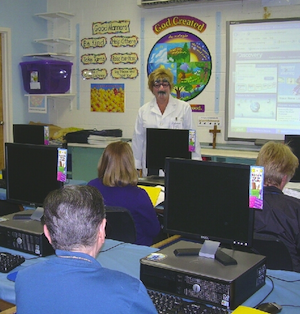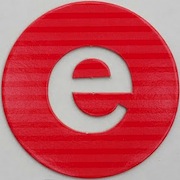Back in late spring, I found myself standing in front of a group of “new” high school teachers in the Diocese of Harrisburg (PA). They ranged in age from wee babes to second careerists. I found myself smiling when I said, “Well, you survived your first year. Congratulations!”
“Your students won’t remember whether it was you who taught them the difference between mitochondrial DNA and a sea cucumber, or a gerund and a dangling participle,” I promised them. “What they will remember is how you engaged them to achieve their personal best, how you made your lessons pertinent to their lives, and how much respect you shared with them.”
As we talked, the fleeting memory of a lesson I learned back in second grade came to me. It was about the power of the letter “e”. My teacher put the word hop on the blackboard, then told us to put our heads down and close our eyes. Several seconds later, we were told to sit up and open our 7-year old eyes. To our surprise, hop was transformed to hope. I marveled that the powerful vowel, when paired with another letter, could actually change the way a third letter says its name. Looking back, I’m still impressed by the impact that this simple proof – small changes can have big effects – had on myself and my young classmates, just beginning to learn the mysteries of the English language.
In our education world, taking the step toward connected learning in our schools — toward eCollaboration, we might say — may feel like a small change to some. But it does indeed transform the way people learn and the way people view themselves and each other. Pope Benedict XVI, in his address for the 43rd World Communication Day, observed:
Young people, in particular, have grasped the enormous capacity of the new media to foster connectedness, communication and understanding between individuals and communities, and they are turning to them as means of communicating with existing friends, of meeting new friends, of forming communities and networks, of seeking information and news, and of sharing their ideas and opinions.
 This ideal level of collaborating — sharing ideas and opinions — calls to mind a school faculty that’s been engaged in doing exactly that, and doing it with Web 2.0 tools. Lebanon Catholic School has been open since 1859 and educates about 400 students pre-K to Grade 12. The faculty and staff of this small school totally understand the power of collaboration.
This ideal level of collaborating — sharing ideas and opinions — calls to mind a school faculty that’s been engaged in doing exactly that, and doing it with Web 2.0 tools. Lebanon Catholic School has been open since 1859 and educates about 400 students pre-K to Grade 12. The faculty and staff of this small school totally understand the power of collaboration.
Since they have been connected to our Diocese’s WAN (Wide Area Network), Mrs. Claire Schneider, the school’s technology coordinator, has created a professional development program that supports even the most techno-fearful teacher. Several times a month, after the dismissal bell rings, about 20 elementary and secondary teachers participate in an hour-long web experience. “It’s so important for them to learn what’s out there and how to use it,” she says. “They come to the class willingly, and they enjoy being here.” (Claire seems to be having fun too, in this picture from one of their first gatherings.)
“It’s a lot for them to teach all day and then come here for an hour, so we do a lot of hands-on activities.” Mrs. Schneider explains. “The key is to get them to learn the technologies, programs and Web sites that are available.”
With this added support, many teachers have jumped in head first. “From our newest teachers to our long-time teachers, everyone has the opportunity to use technology,” she says. “They have embraced it. They want to use it. I’m so thrilled when they tell me they used a new program in their class.”
The collaborative effort is showing results. A seasoned teacher of 48 years now creates Jeopardy games in German for her foreign language students, using the powerpoint-free Jeopardylabs.com. She uploads lesson material and German stories to YouTube. At Lebanon, the Smartboards are always on and ready for interactive use.
Tools are good to have, but what gets done with them is most important. Students publish stories they write online; produce animations; create book trailers; use SMART response systems to share knowledge about specific topics within the curriculum; construct new planets within far off solar systems and describe their features; view on online surgery videos; and edit and upload their multimedia and still images for parents and other students to see.
The synergy generated by Lebanon’s professional development program is palpable to any visitor. Teachers are not only sharing the latest tools they’ve discovered with one another, they’re collaborating on lesson design and project ideas. In this new digital world, aptly described by the Pope, teachers are also learning from their highly connected students.
In our classrooms and PD workshops, we’re all engaged together in the sometime messy process of learning, and small changes are yielding big results. Hurray for the Power of the final ‘e’!
Sr Geralyn Schmidt
Latest posts by Sr Geralyn Schmidt (see all)
- Virtual Integrity and the Digital Citizen - April 27, 2019
- Eight Aspects of Good Teaching - December 4, 2013
- Does Your School Need a Culture Re-Boot? - August 15, 2013



What exciting news this is…and I agree that when people catch the collaboration fever, it spreads like wildfire. Things will only get better and better….because imagine how all that combined brainpower will find.
I know that when I’ve had the chance to work with other creative people, I have become more willing to try new things. Some people might think you’d worry about failing in front of others….but actually I’ve found that you’re so inspired from the supportiveness of this kind of community, that you’re able to experiment, debrief and learn from everything you do.
Congratulations to Mrs. Schneider and Lebanon Catholic School for collaborating their way thru changes and thanks to you for sharing this story.
Marsha,
Thanks for your comment! Creativity is indeed contagious because it allows ones entire being to respond to the task at hand. A mechanical engineer would say, “All pistons are charged and burning!”
True creativity is fascinating to me. Its a response that goes deeply inside a person. I guess that is why others respond to it.